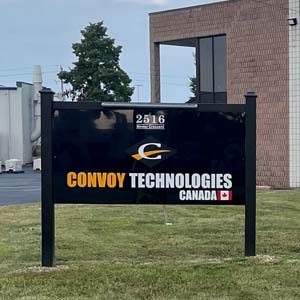Early Recognition of Supply-Chain Risks
Ron Harker knew that China posed a potential problem for his company even before the lockdowns started in 2020. As the president of a business that deals in imported electronics, he had made a point of doing his research about our country’s relationship to the region. Reading the work of geopolitical strategists like Peter Zeihan and George Friedman, Harker realized that the question was when, not if, big changes were going to rock the supply chains his company depended on.
Reliability, Not Just Technology
Then, when the pandemic hit and everything stopped moving, he took a hard look at his industry. Convoy Technologies provides cameras, monitors, and sensors that are installed on a variety of vehicles to improve safety and performance while protecting drivers from unwarranted litigation. What he came to understand, though, is that with a few notable exceptions, what determines competitive success in the market for truck cameras isn’t the technology.
Competitive Edge Through Manufacturing Control
Many fleet managers look for visibility enhancement tools that meet pretty standard needs, and they look for partners who can provide that equipment on the shortest possible timescale, at the lowest possible cost. What the supply chain fiasco of the early 2020s made clear to Harker was that to outcompete other providers, Convoy Technologies didn’t need to invent a new series of cameras or a new type of monitor (though innovative technology is still something the company prides itself on). What they needed was mastery over their own manufacturing and more reliable access to their products.
Nearshoring Strategy: Building in North America
So, in April of 2021, Harker decided Convoy Technologies needed to build a factory in North America. After researching a wide range of potential locations for the new facility, Harker and his team of advisors settled on Windsor, Ontario. Things progressed quickly from there. Planning with a variety of local partners and investors began as early as 2022. Construction began in 2024, with an official launch slated for mid-2025.
Shorter Lead Times and Cost Control
Harker explains: “If the pandemic has taught us one thing, it is that having control over your supply chain is the key to getting products to your customers quickly and reliably. Sourcing parts closer to home and assembling them in North America will ultimately give us shorter, more predictable lead times. And it will eventually help us contain total costs, meaning our customers can count on continued supply and competitive pricing.”
Tariffs and USMCA Advantage
Then, in early 2025, we all started hearing about tariffs on goods coming into the States from Canada. While the announcement of a 25% tariff on everything coming from their new factory caused some at Convoy Technologies to panic, Harker was able to reassure them that the logic of his nearshoring plan remained perfectly sound. That’s because nearly all the company’s competitors will still be getting their cameras, monitors, sensors, and accessories from China, where the tariff quickly jumped to over 100 percent. Harker’s team also discovered that a majority of the products crossing the Canadian border will be exempted from the tariffs under USMCA.
That means not only will Convoy Technologies still be able to provide these products with shorter, more reliable lead times, but will also be able to pass on savings from lower freight prices and much lower tariffs along the way.
Strategic Windfall and Next Steps
Harker obviously hadn’t predicted there would be massive tariffs on goods from China back in 2020. His insight, rather, was that the closer and more easily managed the production of his company’s products the better. There are still plenty of challenges concerning the sourcing of raw materials and questions around what components are best assembled in which country, but by moving the key stages of manufacturing closer to home, Convoy Technologies will enjoy a type of flexibility their competitors can only dream of.
And so the tariffs, if anything, amounted to a windfall for Convoy Technologies. When members of his sales team asked him what the next stage of his plan was, Harker smiled and said, “Let’s start making calls to some of our competitors and see if maybe they want us to build some of their products at our new factory.”




